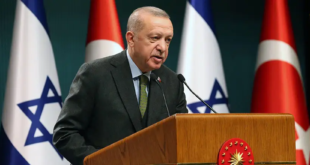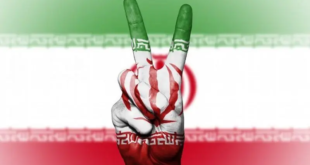WASHINGTON – A new U.S. intelligence report concludes that Iran’s nuclear weapons development program has been halted since the fall of 2003 because of international pressure — a stark contrast to the conclusions U.S. spy agencies drew just two years ago.
The finding is part of a National Intelligence Estimate on Iran that also cautions that Tehran continues to enrich uranium and still could develop a bomb between 2010 and 2015 if it decided to do so.
The conclusion that Iran’s weapons program was still frozen, through at least mid-2007, represents a sharp turnaround from the previous intelligence assessment in 2005. Then, U.S. intelligence agencies believed Tehran was determined to develop a nuclear weapons capability and was continuing its weapons development program. The new report concludes that Iran’s decisions are rational and pragmatic, and that Tehran is more susceptible to diplomatic and financial pressure than previously thought.
“Tehran’s decision to halt its nuclear weapons program suggests it is less determined to develop nuclear weapons than we have been judging since 2005,” says the unclassified summary of the secret report.
The findings come at a time of escalating tensions between the United States and Iran, which President Bush has labeled part of an “axis of evil,” along with Iraq and North Korea. At an Oct. 17 news conference, Bush said, “If you’re interested in avoiding World War III, it seems like you ought to be interested in preventing them (Iran) from having the knowledge necessary to make a nuclear weapon.”
Rand Beers, who resigned from Bush’s National Security Council just before the Iraq war, said the report should derail any appetite for war on the administration’s part, and should reinvigorate regional diplomacy. “The new NIE throws cold water on the efforts of those urging military confrontation with Iran,” he said.
A spokesman for Iran’s U.N. mission declined to comment.
Senior intelligence officials said Monday they failed to detect Iran’s fall 2003 halt in nuclear weapons development in time to reflect it in the 2005 estimate.
One of the officials said Iran is the most challenging country to spy on — harder even than North Korea, a notoriously closed society. “We put a lot more collection assets against this,” the official said, “but gaps remain.” The officials spoke on condition of anonymity because of the sensitivity of the subject.
Some of the changes in the new report reflect the use of “open source” intelligence — public information from sources such as the news media and international organizations. An official said, for example, that photos taken at Iran’s Natanz nuclear facility during U.N. inspections in 2002 were particularly useful in assessing the capabilities of the civilian uranium enrichment program.
U.S. National Security Adviser Stephen Hadley, said the risk of Iran acquiring a nuclear weapon remains “a serious problem.” The estimate suggests Bush “has the right strategy: intensified international pressure along with a willingness to negotiate a solution that serves Iranian interests, while ensuring the world will never have to face a nuclear armed Iran,” Hadley said. He was less interested in what the 2005 assessment missed than what it got right: that Iran had a covert nuclear program.
Bush was briefed on the 100-page document on Nov. 28. National Intelligence Estimates represent the most authoritative written judgments of all 16 U.S. spy agencies. Congress and other executive agencies were briefed Monday, and foreign governments will be briefed beginning Tuesday, the officials said.
Despite the suspension of its weapons program, it may be difficult to ultimately dissuade Tehran from developing a nuclear bomb because Iran believes such a weapon would give it international prestige and leverage to achieve its national security and foreign policy goals, the assessment concluded.
“The bottom line is this: For that strategy to succeed, the international community has to turn up the pressure on Iran with diplomatic isolation, United Nations sanctions, and with other financial pressure and Iran has to decide it wants to negotiate a solution,” Hadley said.
The intelligence officials said they do not know all the reasons why Iran halted its weapons program, or what might trigger its resumption. They said they are confident that diplomatic and political pressure played a key role, but said the U.S. invasion of Iraq, Libya’s termination of its nuclear program and the implosion of the illegal nuclear smuggling network run by Pakistani scientist A.Q. Khan might also have influenced Tehran.
To develop a nuclear weapon, Iran needs to design and engineer a warhead, obtain enough fissile material, and build a delivery vehicle such as a missile. The intelligence agencies now believe Iran halted warhead engineering four years ago and as of mid-2007 had not restarted it.
But Iran is still enriching uranium for its civilian nuclear reactors that produce electricity. That leaves open the possibility that fissile material could be diverted to covert nuclear sites to produce highly enriched uranium for a warhead. Engineers have known the design for a nuclear weapon for 60 years. The countdown to a nuclear weapon is determined more by the availability of fissile material than anything else, the officials said.
Even if the country went all out with present enrichment capability, it is unlikely to have enough until late 2009 or 2010 at the earliest, the officials said. The State Department’s Intelligence and Research office believes the earliest likely time it would have enough highly enriched uranium would be 2013. But all agencies concede Iran may not have sufficient enriched uranium until after 2015.
Iran would not be able to technically produce and reprocess enough plutonium for a weapon before about 2015, the report says. But ultimately it has the technical and industrial capacity to build a bomb, “if it decides to do so,” the intelligence agencies found. They said Iran’s immediate intentions are a mystery.
“We do not have sufficient intelligence to judge confidently whether Tehran is willing to maintain the halt of its nuclear weapons program indefinitely while it weighs its options, or whether it will or already has set specific deadlines or criteria that will prompt it to restart its program,” the report says.
This national intelligence estimate was originally due in the spring of 2007 but was delayed because the agencies wanted more confidence their findings were accurate, given the inaccuracy of the 2002 intelligence estimate of Iraq’s weapons of mass destruction program.
Senate Intelligence Committee Chairman Jay Rockefeller, D-W. Va., said the report showed “a level of independence from political leadership that was lacking in the recent past.”
The CIA, which did most of the analysis, considered at least six alternate scenarios that could explain the new findings, including whether Iran was intentionally trying to deceive them into believing weapons work had stopped.
Director of National Intelligence Mike McConnell decided last month that key judgments of NIEs should not be declassified and released. The intelligence officials said an exception was made in this case because the last assessment of Iran’s nuclear program in 2005 has influenced public debate about U.S. policy toward Iran, and must be updated to reflect the latest findings.
Also Monday, a top U.S. diplomat said China may be open to discussing fresh U.N. Security Council sanctions against Iran. China and Russia, both veto-wielding members of the Security Council, have been reluctant to support new sanctions.
 Eurasia Press & News
Eurasia Press & News



